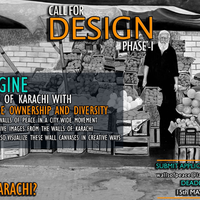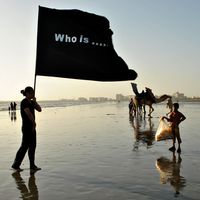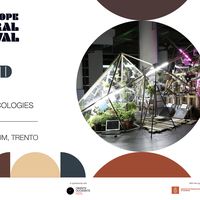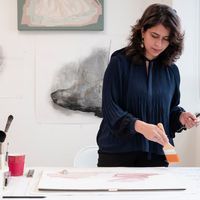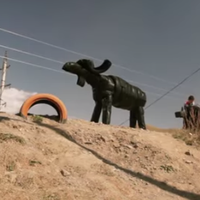Reel On Hai | A Public Outreach Project of the Karachi Biennale 2017
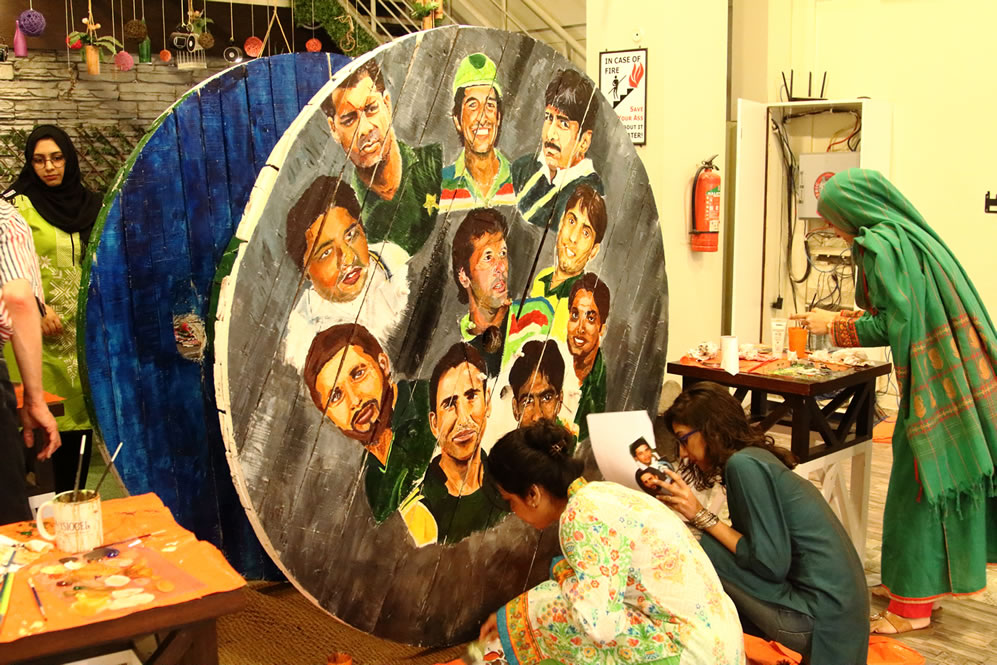
With a population of over 24 million, Karachi is home to a very ethnically diverse population. It has grown in size from a small coastal settlement to a mega city after the independence of the country, to accommodate a large migrant population. Today it is a cultural microcosm of the country, as historically it has opened its arms to all who are drawn here by the opportunities and often the sanctuary it offers.
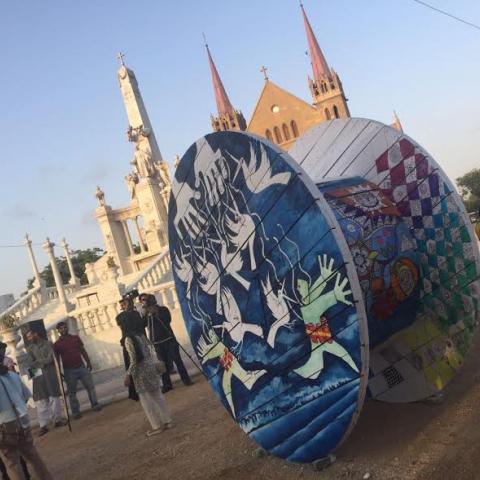
A city that sees constant expansion, construction sites are abundant and so are the empty cable reels that are often discarded.
This cable reel can also be seen as the symbol of the industry that changed a sleepy harbour town into the manufacturing powerhouse of the country. The miles of cable these reels hold are the tentacles that deliver power to the rapidly expanding neighborhoods and growing industry.
One of Karachi’s most pressing problems has been the inadequate solid waste management rendering this city ugly by the excessive garbage it produces. Art from discarded objects is therefore a powerful green gesture that enables recycling of waste and elevating it with imagination and innovation.

Living in an area of Karachi that is relatively new and still being developed, I used to come across a lot of empty cable reels near my house. Made of wooden planks, the surface of the disks were ideal for creating art or converting them into usable design. Igniting my passion, this became the start of a two year long creative journey which was named ‘Reel On Hai’. This ambitious project was aimed at rescuing an industrial waste product and recycling it into art. As a trustee and founder member of The Karachi Biennale, I presented the concept to them and we decided to make it the main outreach project of the KB17. Armed with a vision and a workable concept, I invited a group of like-minded professionals to help me execute a multiple reel project and fine tune the idea. The group which included artists, architects, educationists, designers and students formed the Public Outreach Committee of the KB17.
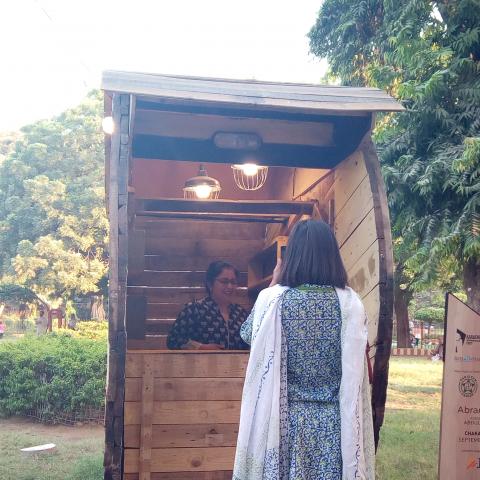
With the largest cable manufacturers in the country, Pakistan Cables came on board as the ‘Main Activity Partner’. An open call was sent out via social media, to artists, architects and designers, to come up with interesting and innovative ways to transform this otherwise mundane object to something riveting.
Permissions from the government for placing the reels at public sites were difficult to come by. The alternative was to position the spools at semi-public spaces where maximum public interaction could be garnered. The next step was the selection and placement of artworks so that people living in and around the area could relate to them. Our first reel was placed at an area in north-western Karachi called Orangi Town. Home to over 2.5 million people from various ethnicities, Orangi is a microcosm of Karachi.
Art with figures is not looked at favourably by a large section of the population. We therefore felt that the residents of Orangi would connect better with calligraphy. The artist we chose was a famous graffiti artist named Sanki King who covered the reel with calligraphic quotes by 3 Pakistani icons.
The second reel was placed in the heart of old Karachi.
Constructed in 1881, The Saint Patrick’s Cathedral is a magnificent structure and the oldest church in the city. The area around the church is inhabited by Goan Christians who speak primarily in English. There are also 6 English medium, convent schools around the church. Artist/political cartoonist Feica’s cartoons feature in Pakistan’s largest circulated English daily. Feica created the artwork with his daughter. The work references interfaith harmony, tolerance and peace. They encouraged spectators to paint with them.
All subsequent artworks were also placed after equal deliberation and consideration. Parks, hospitals, colleges, universities, hotels, the central jail, Karachi zoo, and many other high footfall places. These reels now dot the urban landscape of Karachi.
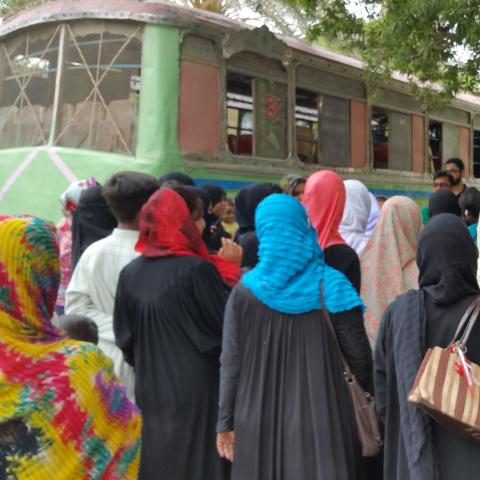
So far around 39 reel artworks created by 58 artists have been installed at various locations around Karachi. From Orangi Town to Saddar from Gulshan-e-Maymar to Garden East, artists, designers and architects both local and international, have worked on site to not just create art but also to engage communities living around the area
Other than creating a successful collaboration between the artists and the corporate sector, the most encouraging part about this project was that it managed to rope in the stakeholders of the city. The Public Outreach Committee of the Karachi Biennale 2017 managed to unite artists, designers, businessmen, educators, consulates, the Catholic archdiocese, doctors, hoteliers and students. Everyone gave freely of their time and talent for the betterment of the city.
While local communities took ownership of the reels as well as a muted sense of pride, the media was fulsome in its appreciation. Major publications such as Express publications, Daily Dawn covered the project, electronic media too gave the project ample coverage. The project has been well received in general and today the reels remain silent witnesses to Karachi’s urban chaos.
Masuma Halai Khwaja is an artist, art educator and curator. She is a Founder member, Trustee and Chairperson for the Public Outreach Committee of the Karachi Biennal Trust.
Masuma wishes to thank all the team members who worked tirelessly towards the project: Nasheed Imran, Bina Ali, Mohsin Saeed, Khushbu Shaukat, Fatema Mandviwala, Ali Imani, Shehzar Abro, Safa Fareed, Zoya Nasir, Ambareen Thompson, Ainee Shehzad.
Read more:
- https://www.facebook.com/ReelOnHai/
- https://www.dawn.com/news/1272946
- http://newslinemagazine.com/magazine/reel-hai-project-karachi-biennale-2017/
Similar content
deadline
10 Aug 2016
deadline
15 May 2017
from - to
30 Aug 2024 - 07 Sep 2024
posted on
01 Mar 2019
posted on
17 Nov 2014


